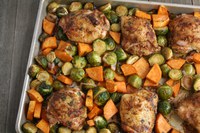Prairie Fare: What Are Your Favorite, Least Favorite Vegetables?
(Click an image below to view a high-resolution image that can be downloaded)
By Julie Garden-Robinson, Food and Nutrition Specialist
NDSU Extension
“Have some Brussels sprouts,” my husband said to our kids when they were much younger. “They look like little green brains.”
Well, that certainly was an enticement, I recall thinking to myself.
I gave him “the look.”
All the Brussels sprouts remained on our kids’ plates after the meal.
I think my husband ate their Brussels sprouts, too. Maybe that was the goal.
I reminded him of the Brussels sprouts event one evening.
“I love Brussels sprouts with a little butter,” he noted. “‘Alien brains’ are really good.”
Maybe that’s what he called them years ago. I do not think our kids ever ate Brussels sprouts, even though the two of us enjoy them.
What are your top two favorite vegetables? How about your two least favorite vegetables?
In 2019, a poll of 2,000 people gathered the “most liked” and “least liked” vegetables among U.S. residents.
Corn and potatoes were the top two favorites, and carrots and tomatoes tied for third place.
Yes, we in the nutrition field count tomatoes as vegetables, even though botanically, they are the “fruit” of the plant.
Onions and green beans also were top-rated vegetables with an 85% approval rating.
What were the least favorite veggies among U.S. residents?
Turnips, beets and radishes were the top three least favorite vegetables.
Brussels sprouts were the fourth least liked vegetables. I wonder if my kids were surveyed.
Artichokes rounded out the top five least liked vegetables.
Many people in the U.S. like several different vegetables, which is a good thing. However, three out of four people in the U.S. do not meet the daily vegetable goals, according to the recently released Dietary Guidelines for Americans 2020 to 2025.
Most adults should aim for 2 1/2 to 3 cups of vegetables every day. The amount recommended for kids varies, but it averages about 2 1/2 cups per day. The majority of children do not eat enough vegetables.
See https://www.myplate.gov for a personalized plan showing the five food groups for your age and activity level.
Eating plenty of vegetables has several potential health benefits. They are rich in fiber and naturally low in calories. Many vegetables provide vitamins A and C and minerals such as potassium.
Eating a diet rich in vegetables as part of an overall healthful diet may reduce your risk for heart disease, cancer and other chronic diseases.
In fact, cruciferous vegetables such as Brussels sprouts, cabbage, broccoli, cauliflower, kale and bok choy have been studied as potential cancer fighters.
In some studies, people who ate more cruciferous vegetables had a lower risk of some types of cancer, including colon, lung and prostate. In other studies, researchers did not find a strong relationship.
Nutrition research is challenging because people have a hard time remembering what they ate.
Green cruciferous vegetables are particularly high in vitamins A and C, plus the B vitamin folate and “phytonutrients” (plant nutrients). We need all of these nutrients to nourish our bodies.
I invite you to join our free webinars (online seminars) all about growing, preparing and preserving vegetables in our annual “Field to Fork” webinar series beginning in mid-February. You also can learn about donating vegetables next summer and information about starting a food-related business.
See https://www.ag.ndsu.edu/fieldtofork to register. While at the site, click on “Learn More About Specialty Crops” banners to learn about a wide variety of vegetables and fruits.
Here’s a delicious one-pan meal that features, you guessed it, Brussels sprouts. Give them a chance.
Paprika Chicken and Vegetables One-pan Meal
6 chicken thighs
1/4 tsp. salt, divided
1 lb. Brussels sprouts, trimmed and halved
2 sweet potatoes, peeled and cubed
2 shallots, peeled and quartered (or substitute 1/2 mild onion)
3 1/2 tsp. garlic, minced, divided
3 Tbsp. olive oil (plus more for drizzling)
1 Tbsp. fresh lemon juice
Spice Mixture
2 Tbsp. sweet paprika, divided
1 tsp. dried cilantro, divided
1 tsp. allspice, divided
Preheat the oven to 425 F. Sprinkle chicken lightly with salt on both sides and set aside. Place the Brussels sprouts, potatoes and shallots on a large sheet pan. Season the vegetables lightly with salt and drizzle olive oil, then toss the vegetables to mix. In a small bowl, mix the spices. Sprinkle 1 Tbsp. of the spice mixture on top of the veggies. To the remaining spice mixture, add 2 tsp. garlic, 3 Tbsp. olive oil and 1 Tbsp. lemon juice. Stir into a paste. Brush both sides of the chicken and under the skin with this paste. Add chicken to the pan, and sprinkle remaining minced garlic on top of the chicken and vegetables. Roast for about 35 minutes, or until the chicken reaches an internal temperature of 165 F and the vegetables are tender.
Makes six servings. Each serving has 360 calories, 21 grams (g) fat, 17 g protein, 28 g carbohydrate, 7 g fiber and 210 milligrams sodium.
(Julie Garden-Robinson, Ph.D., R.D., L.R.D., is a North Dakota State University Extension food and nutrition specialist and professor in the Department of Health, Nutrition and Exercise Sciences. Follow her on Twitter @jgardenrobinson)
NDSU Agriculture Communication - Jan. 21, 2021
Source: Julie Garden-Robinson, 701-231-7187, julie.garden-robinson@ndsu.edu
Editor: Ellen Crawford, 701-231-5391, ellen.crawford@ndsu.edu




